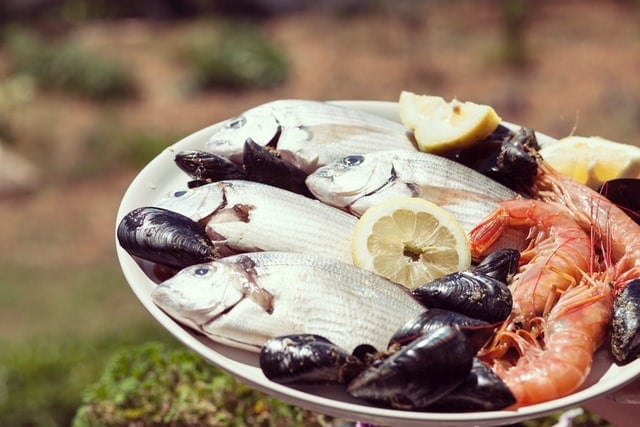Intermittent fasting (IF) is an eating pattern proven to have beneficial health outcomes used frequently for weight loss. Perhaps you’ve just started experimenting with the strategy or have been practicing IF for some time with sub-optimal results. This article briefly explains intermittent fasting and the metabolic changes you experience while in a fasted state and then focuses on how to break your fast. What you eat during your fueling window plays an essential role in extending and amplifying IF’s benefits.
For the normal person practicing IF, some general rules apply regarding the foods best tolerated when you break your fast. We’ll explain why in just a moment. However, there is more to consider for the person who’s looking to build or maintain muscle while shedding excess body fat. The food, supplements, and timing of your exercise and fueling windows are crucial to achieving these more advanced goals. So, wondering what to eat after fasting? We’ve done the research; let’s dive in!
Intermittent Fasting is a Pattern of Eating
Intermittent fasting is not a diet, per see like a vegetarian or ketogenic diet; rather, it is an eating pattern, a strategy of abstaining from food for a set period, followed by a fueling window. You repeat the cycle throughout the week, with some practitioners enjoying one day designated as a cheat day or for a cheat meal. Science tells us that you must abstain for a minimum of twelve hours to achieve a fasted state and trigger the metabolic switch.
One of the many benefits of IF is that you choose your “wait period,” which is the length of your fast. Two of the more popular types of intermittent fasting are the 16:8, you fast for sixteen hours and then consume your daily intake in the next eight hours; and the “fast five,” you guessed it, you fast for nineteen hours and eat for only five hours. There are also alternate day fasts, the 12:12 and the 5:2, somewhat different as you eat as normal for five days and fast or severely restrict caloric intake for two days.
All fasts have one thing in common, at some point, you reintroduce food and break your fast.
Intermittent Fasting Goals
To achieve the benefits of IF, you have two goals:
- Calorie reduction – by shortening your feeding window, there is less time for meals (and snacking). Unless you overindulge during your feeding window, you should reduce your daily caloric intake.
- Enter ketosis – IF speeds the onset of ketosis – a state in which the body begins to use fat stores as its primary energy source when carbohydrates are unavailable.
Two Rules for Breaking Your Fast
Rule number one is pretty obvious; once you consume calories, you have broken your fast. Just be sure you don’t do so inadvertently. That means no food or calorie-containing beverages – nothing that would raise your blood insulin levels. To be safe, we recommend against artificially sweetened soft drinks, omegas, and BCAAs during your fasting window.
Rule number two, understand that you can break your fast without exiting ketosis. Some experts who combine IF with keto, or another low-carb diet, allow healthy fats such as omegas or fish oil, MCT Oils, or BCAAS during a fast as they should not cause you to exit ketosis; however, you have broken your fast.
When it comes to what you can drink while fasting, our recommendation is you consume only water, black coffee (sans the grass-fed butter), and green tea to maintain your fast. The rules of fasting can be complicated, which is why new technology, like the DoFasting app, that can help you track your IF progress can be beneficial while trying to maintain a fast.
Reintroducing Food After Your Fast
For the average person seeking intermittent fasting’s health benefits, including weight loss, strict adherence to tracking macronutrients during feeding windows is not essential. When practicing IF, the body naturally reduces its production of digestive enzymes. For this reason, the first meal after your fast, your breakfast (no matter the time of day), should be foods that are easily digestible, in a somewhat smaller amount, to avoid gastrointestinal discomfort. To prevent spiking blood sugar levels, this first meal should also have a lower glycemic index.
Some examples of more easily digested foods would include eggs for protein, bone broths, fermented foods/yogurt, cooked vegetables, and healthy fats. If weight loss is your goal, foods that will maintain ketosis, healthy fats, and protein can keep burning fat even after breaking your fast. Smoothies, eggs, chicken with mixed greens and healthy oil, and salmon are good choices to break your fast without kicking you out of ketosis.
For those combining IF with a ketogenic diet, you will need to monitor your macros during your fueling windows, reverting to a ratio approaching 70% from healthy fats, 20% protein, and 10% carbohydrates.
What To Eat After Fasting – Maintaining Muscle and Improving Body Composition
When your reason for adopting an intermittent fasting lifestyle is to improve your body composition dramatically, retaining or building muscle while shedding excess body fat, your feeding strategy changes, macronutrients now count. Macronutrients now count. Getting sufficient nutrients in a shortened eating window becomes more challenging. Extending the fat-burning process of ketosis while ensuring adequate intake for protein synthesis and muscle development are the objectives.
Our solution is a combination of IF with exercise/training, a low-carb, slow-carb diet, and sufficient quality protein. This approach, the foods you eat during your feeding window, in the correct proportions, coupled with essential supplementation, can dramatically accelerate your results. That said, if getting massive and building significant muscle is your goal, IF is probably not your best strategy. In that case, a bodybuilder’s diet, with protein intake every two-three hours, is preferred.
We will assume a 16:8 strategy to illustrate an IF and low-carb diet. Given an eight-hour feeding window, your challenge is to consume a full day’s nutrients in less time than normal. This requires more frequent meals and timing your workouts and supplementation.
Timing Your Workouts and Meals
For most, IF is more about when you eat versus what you eat. For those supplementing, some products are acceptable during a fast, while others are best left to feeding periods. For the person with more aggressive goals, workout timing, supplement timing, and macronutrients during fueling sessions become more important.
You can work out while in a fasted state. Cardio may be even more beneficial when fasting to burn body fat. However, heavy resistance training is best suited to times during or after your eating window as it’s difficult to build muscle in a calorie deficit. If you wish to retain your hard-earned muscle, training around your feeding window is crucial. You need nutrients when working out to make gains in strength, endurance, and muscle. It’s even more essential to have certain nutrients available for repair and recovery after your workout. Remember, if you use a pre-and/or post-workout, they must be consumed during a feeding window to avoid breaking your fast unintentionally.
When considering your fasting pattern, be sure to accommodate your workout schedule. An ideal plan would allow for a protein drink and pre-workout at least thirty minutes in advance of training. One important caveat, even when on a keto diet, too much protein in one setting can kick you out of ketosis through gluconeogenesis. Within thirty minutes or so of exercise, you should then take your post-workout drink for repair and recovery.
One hour later, you would have your breakfast meal. Within the next five hours, you will need to have your lunch, snacks, and dinner. If necessary, double up on meals, add an extra serving of healthy fats, such as an avocado, and a protein shake, as required to achieve your targeted macronutrients. Fast for the next sixteen hours and repeat.
Best Foods When Practicing Intermittent Fasting
The foods in our low-carb, slow-carb approach, when coupled with IF, will look similar to a ketogenic diet, featuring healthy fats and high-quality protein with vegetables making up most of your carbohydrates. Avoid white carbohydrates like bread, rice, pasta, potatoes, tortillas, cereal, and breaded fried foods.
- Eggs and egg whites
- Fish and seafood
- Lean meat, grass-fed if possible
- Poultry
- Nuts and seeds
- Bone broth
- Beans and legumes
- All-natural peanut butter
- Low-fat cottage cheese
- Avocados
- Plain yogurt
- Dark Chocolate
- Low-carbohydrate vegetables
- Healthy oils, extra virgin olive oil, coconut oil, MCT oils
In addition to these foods, supplementation is an important consideration during IF and low-carb dieting. Supplements can enhance the effects of IF provided they are taken at the right time. Protein powders are a staple, with popular options like Pro JYM and Clean Green Protein. So are pre-, and post-workout supplements such as BlackWolf Pre-Workout and Clear Muscle Post Workout. Other recommended supplements include BCAA (Branched-chain amino acids) or EAAS (full-spectrum amino acids), a good multivitamin/mineral, electrolytes to offset potential dehydration while fasting, fish oil, ZMA, pre-and probiotics, exogenous ketones, and L-glutamine. Other than ZMA, electrolytes, and a multivitamin/mineral with no added calories, these supplements are best taken during your feeding window.
In Summary: Eating After Fasting
We are major proponents of the IF lifestyle and provide the above to avoid unintentionally breaking your fast or exiting ketosis. The proper foods and supplements can enhance your program if timed correctly. Although consuming sufficient nutrients in a time-restricted eating pattern can be challenging, sticking to the basic rules described above can make the effortless onerous.
One last caution, perhaps worse than an inadvertent mistake in breaking your fast, over-indulging with the wrong foods during your eating window can derail your progress.
Be smart, maintain your fast, and extend the benefits of ketosis with the right foods to break your fast.
















